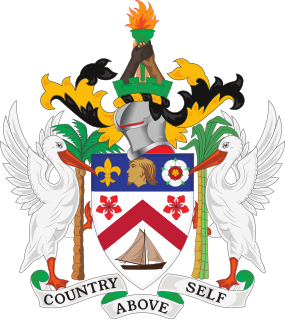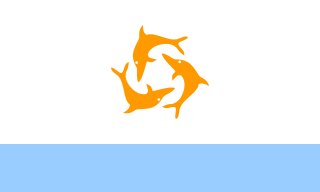 |
|---|
General elections were held in Anguilla on 30 July 1968.
 |
|---|
General elections were held in Anguilla on 30 July 1968.
Following the Anguillian Revolution in May 1967, a referendum on separating from St Kitts and Nevis was held on 11 July, in which 99.7% voted in favour of separation. [1] Independence was declared the following day as the Republic of Anguilla. [2]
A new constitution was drawn up that provided for a seven-member Legislative Council with five elected members and two appointed members. The first elections were planned for October, but only five candidates stood for the five seats, and all were returned unopposed, with no vote taking place. [3]
Fresh elections were scheduled for July 1968. Contrary to the constitution, seven members were elected and none appointed. [4]
Only two of the seven seats were contested, with Emile Gumbs defeating the incumbent Hugo Rey in Road North and incumbent Wallace Rey defeating Clement Daniels in Valley South. [5] Atlin Harrigan, Kenneth Hazel, Collins Hodge, John Hodge and Ronald Webster were elected unopposed. [3]
The British government took control of Anguilla in 1969, with members of the 1968 council allowed to continue in office. Seven additional members were appointed to the Legislative Council; Camille Connor, Samuel Fleming, Winston Harrigan, Reuben Hodge, Hugo Rey, Russell Webster and James Woods. [4]

Nevis is a small island in the Caribbean Sea that forms part of the inner arc of the Leeward Islands chain of the West Indies. Nevis and the neighbouring island of Saint Kitts constitute one country: the Federation of Saint Kitts and Nevis. Nevis is located near the northern end of the Lesser Antilles archipelago, about 350 kilometres (220 mi) east-southeast of Puerto Rico and 80 kilometres (50 mi) west of Antigua. Its area is 93 square kilometres (36 sq mi) and the capital is Charlestown.

The politics of Saint Kitts and Nevis takes place in the framework of a federal parliamentary democracy. Saint Kitts and Nevis is an independent Commonwealth realm with Charles III as its head of state, viceregally represented by a Governor-General. He acts on the advice of the prime minister, who is the majority party leader in the National Assembly, and who, with a cabinet, conducts affairs of state.
The history of Anguilla runs from the beginning of human habitation, probably via settlement from South America, through its colonization by the English in the early modern period, to the present day. Following a series of rebellions and a short-lived period as an independent republic during the 1960s, Anguilla has been a separate British overseas territory since 1980.

Saint Christopher-Nevis-Anguilla was a British colony in the West Indies from 1882 to 1983, consisting of the islands of Anguilla, Nevis, and Saint Christopher. From 1882 to 1951, and again from 1980, the colony was known simply as Saint Christopher and Nevis. Saint Christopher and Nevis gained independence in 1983 as the Federation of Saint Kitts and Nevis, while Anguilla would remain a British overseas territory.
James Ronald Webster (2 March 1926 – 9 December 2016) was a politician from Anguilla. After ending the Saint Christopher-Nevis-Anguilla federation in 1967, he served as the island territory's first Chief Minister from 10 February 1976 to 1 February 1977 and again from May 1980 to 12 March 1984.

The National Assembly and the King of Saint Christopher and Nevis jointly make up the legislature of Saint Kitts and Nevis.

The monarchy of Saint Kitts and Nevis is a system of government in which a hereditary monarch is the sovereign and head of state of Saint Kitts and Nevis. The current monarch of Saint Kitts and Nevis, since 8 September 2022, is King Charles III. As sovereign, he is the personal embodiment of the Crown of Saint Kitts and Nevis. Although the person of the sovereign is equally shared with 14 other independent countries within the Commonwealth of Nations, each country's monarchy is separate and legally distinct. As a result, the current monarch is officially titled King of Saint Christopher and Nevis and, in this capacity, he and other members of the royal family undertake public and private functions domestically and abroad as representatives of Saint Kitts and Nevis. However, the King is the only member of the royal family with any constitutional role.

General elections were held in Anguilla on 15 February 2010. Seven seats in the House of Assembly were contested in the election.

The Republic of Anguilla was a short-lived, unrecognised independent state on the island of Anguilla. It lasted from 11 July 1967 until 19 March 1969, when British control was re-established.

General elections were held in Saint Kitts-Nevis-Anguilla on 6 October 1952, the country's first elections held with universal suffrage. The Workers' League won seven of the eight elected seats.

General elections were held in Saint Kitts-Nevis-Anguilla on 16 November 1961. The result was a victory for the Saint Kitts-Nevis-Anguilla Labour Party, which won seven of the ten elected seats.

A referendum on separating from Saint Kitts and Nevis was held in Anguilla on 11 July 1967. In February Anguilla had become part of the Saint Christopher-Nevis-Anguilla federation. However, on 30 May the police were expelled and a "Peace Keeping Committee" installed as a government. The referendum was approved by 99.72% of voters, and the following day "President" Ronald Webster declared the separation. However, his new government was not recognised by either the Saint Christopher-Nevis-Anguilla federation or the United Kingdom.

A constitutional referendum was held in Anguilla on 6 February 1969. Following the 1967 uprising on the island, which had seen the local police force expelled, and a referendum on separation, British troops had taken over Anguilla, before leaving in January 1968. On 8 January 1969 Ronald Webster declared independence. A republican constitution was put forward and approved by 99.71% of voters. After the referendum, British troops returned to occupy the island on 19 March.

The Constitution of Saint Kitts and Nevis was adopted on 23 June 1983 and took effect when the country became independent on 19 September 1983. It consists of 11 chapters and various schedules, which establish the rights, responsibilities and definition of the citizens of the federation. It also provides the form and structure of government, and enumerates the powers of the different branches of government. Its treatment of the island of Nevis is rather unusual among federated nations.

General elections were held in Saint Kitts-Nevis-Anguilla on 24 June 1937, the first since the 1870s. The Workers' League nominated two candidates, Thomas Manchester and Edgar Challenger, both of whom were elected.

General elections were held in Saint Kitts-Nevis-Anguilla on 20 September 1943. The Workers' League won all the elected seats, defeating an alliance of merchants and planters nominated by the Agricultural and Commercial Society.

General elections were held in Anguilla on 24 July 1972. The People's Progressive Party won six of the seven seats and its leader Ronald Webster became chair of the council. Webster was later appointed as the first Chief Minister shortly before the 1976 elections.

General elections were planned to be held in Anguilla on 25 October 1967 following the Anguillian Revolution in May. However, only five candidates stood for the five seats, with all elected unopposed.
Operation Sheepskin was a British military operation in the Caribbean, aimed at restoring British rule to the island of Anguilla, after the island had declared itself as an independent Republic. The British government dispatched two Royal Navy ships and 300 soldiers of the 2nd Battalion, Parachute Regiment and 22 officers of the Metropolitan Police to restore order to the island. The operation was a success and British troops were met with no resistance by the islanders, as they had wanted the island to remain a British territory but with direct association with Great Britain, separate from Saint Kitts and Nevis, of which they were a part.

Snap general elections were held in Saint Kitts and Nevis on 5 August 2022, following the decision of incumbent prime minister Timothy Harris to dissolve the parliament on 11 May. Snap elections are constitutionally required within ninety days following the dissolution of parliament.